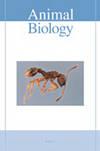日本中部早川的两种管鼻蝙蝠的饮食习惯,Murina hilgendorfi和Murina ussuriensis
IF 0.9
4区 生物学
Q2 ZOOLOGY
引用次数: 1
摘要
了解饮食习惯对了解一个物种的生活史至关重要;然而,关于神秘的Murina属蝙蝠的信息却鲜为人知。在这项研究中,我们使用传统的形态学粪便分析方法,研究了日本中部早川地区4年来的hilgendorfi Murina和ussuriensis的饮食习惯。在希尔根多菲和乌苏里m的粪便中分别发现了6目(已鉴定5科)和5目(已鉴定5科)节肢动物碎片。这两个物种都吃无翅节肢动物(毛毛虫和蜘蛛),很少飞的昆虫(地甲虫和灌木蟋蟀),或昼行昆虫(蜻蜓和食蚜蝇;也就是说,它们在晚上休息),这清楚地表明这些蝙蝠有拾取食物的行为。在春季,体型较大的hilgendorfi更频繁地捕食甲虫和灌木蟋蟀等硬体昆虫,而体型较小的ussuriensis更频繁地捕食毛虫、飞蛾、蜘蛛和双翅目昆虫等软体昆虫,这表明体型的差异影响了它们的食物习惯,这可能导致了这些近亲蝙蝠之间食物资源的分配。对于希尔根多菲蝇来说,甲虫在春季和秋季是主要的猎物,而毛虫和蚱蜢则分别在春季和秋季更频繁地被捕食,这表明它们可能会根据食物供应的季节性波动而改变猎物。据我们所知,这项研究首次记录了这两个物种在饮食习惯上的差异。本文章由计算机程序翻译,如有差异,请以英文原文为准。
Food habits of two species of tube-nosed bats, Murina hilgendorfi and Murina ussuriensis, in Hayakawa, central Japan
Knowledge of food habits is essential for understanding the life history of a species; however, such information about the enigmatic Murina genus of bats is little known. In this study, we examined the food habits of Murina hilgendorfi and Murina ussuriensis over four years in Hayakawa, central Japan, using traditional morphological fecal analysis. Fragments of arthropods of six orders (five identified families), and of five orders (five identified families), were found in the feces of M. hilgendorfi and M. ussuriensis, respectively. Both species consumed wingless arthropods (caterpillars and spiders), insects that rarely fly (ground beetles and bush crickets), or diurnal insects (dragonflies and hoverflies; i.e., that are resting at night) during the night, which is a clear indication of gleaning behavior in these bats. In spring, the large-bodied M. hilgendorfi more frequently consumed hard-bodied insects such as beetles and bush crickets, whereas the small-bodied M. ussuriensis more frequently consumed soft-bodied insects such as caterpillars, moths, spiders, and dipterans, suggesting that the body size difference influences their food habits, which may have contributed to food resource partitioning between these closely related bats. For M. hilgendorfi, beetles were the main prey in spring and autumn, while caterpillars and grasshoppers were more frequently consumed in spring and autumn, respectively, suggesting that they may have changed prey items according to seasonal fluctuations in food availability. To our knowledge, this study provides the first record of differences in the food habits of these two species.
求助全文
通过发布文献求助,成功后即可免费获取论文全文。
去求助
来源期刊

Animal Biology
生物-动物学
CiteScore
2.10
自引率
0.00%
发文量
34
审稿时长
3 months
期刊介绍:
Animal Biology publishes high quality papers and focuses on integration of the various disciplines within the broad field of zoology. These disciplines include behaviour, developmental biology, ecology, endocrinology, evolutionary biology, genomics, morphology, neurobiology, physiology, systematics and theoretical biology. Purely descriptive papers will not be considered for publication.
Animal Biology is the official journal of the Royal Dutch Zoological Society since its foundation in 1872. The journal was initially called Archives Néerlandaises de Zoologie, which was changed in 1952 to Netherlands Journal of Zoology, the current name was established in 2003.
 求助内容:
求助内容: 应助结果提醒方式:
应助结果提醒方式:


